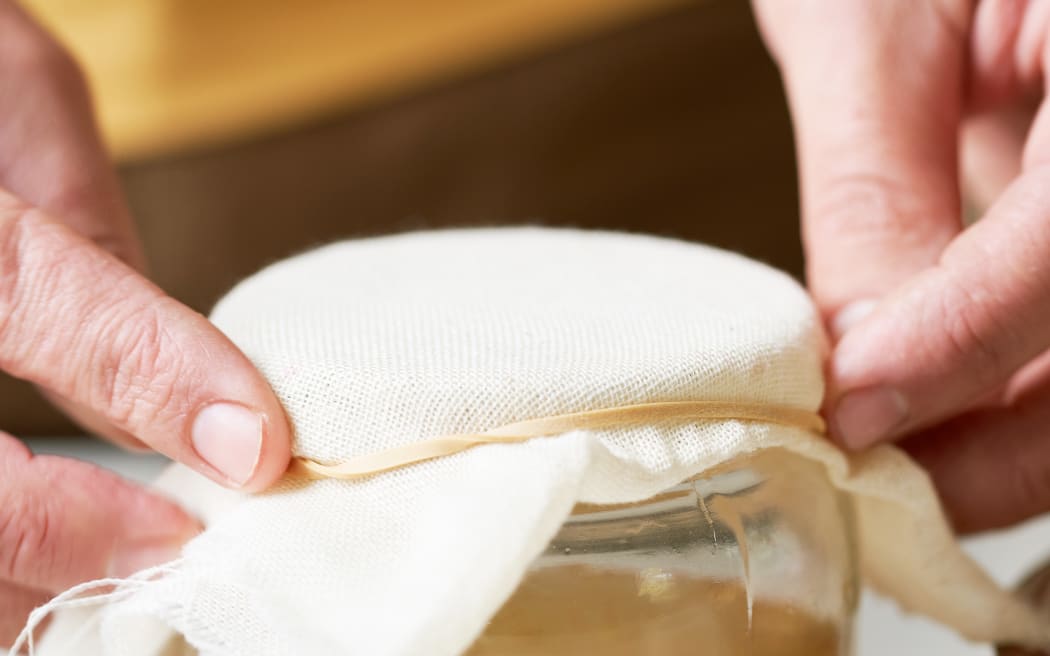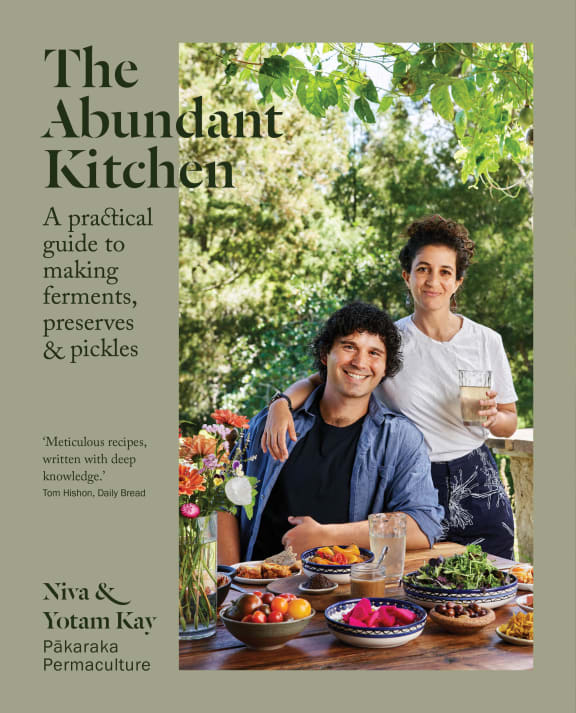How to make your own ginger beer
Yotam and Niva Kay fell in love with real, homemade ginger beer in a West African restaurant in Paris in 2007. They've perfected their own recipe for a rich, yummy ginger beer drink, which includes a ginger beer 'bug' that can be used in other drinks and bakes. Here's how they do it.

Ginger beer in the making. Photo: Aaron McLean
Ginger Bug Starter
The key to making bubbly-rich ginger beer is making the microbes come alive, feasting on ginger and sugar in what’s referred to as the ‘ginger bug’. Once the ginger bug is bubbly, we brew a sweet ginger tea, let it cool down, add a bit of lemon juice and the ginger bug, and bottle it all up. So easy and so good.
Making a ginger bug will be a process that spreads over a few days and up to a week, but it probably will not take you more than 10 minutes throughout that time.
For this recipe, you will need a wide jar of over 400 ml (14 fl oz) to make the ginger bug, and another small jar to keep the finely cut or grated ginger to feed the ginger bug in.
We tried making the ginger bug starter with honey instead of sugar a few times, but it wasn’t as smooth and quick. We prefer and recommend using sugar and not honey to start and feed the ginger bug.
- 10 cm (4 in, 60–80 g/21–23 oz) piece fresh ginger, skin on and trimmed of any mould
- 5–9 teaspoons sugar
- 1 cup water
Chop or grate the ginger finely. Take 2 teaspoons of the finely grated or cut fresh ginger and place it in a large wide jar (400 ml/14 fl oz or more). Place the remaining ginger in a small jar in the fridge. You will be using it over the coming few days.
Add 2 teaspoons of the sugar to the jar and top it up with the water. Stir the mixture until the sugar is dissolved, and cover it tightly with a clean cloth so flies can’t get in. Place the jar in a warm spot out of direct sunlight but in a highly visible place, which will help you remember it.
As much as there is nothing mystical about this process, for a measure of good luck and a bit of fun, we make a silent invitation (or, if one of our kids is around, Yotam will make an exaggerated loud one) for the ginger beer-loving yeast to enjoy this feast.
Over the next few days, once a day (twice is even better but don’t feel pressured), add 1 teaspoon of grated ginger from the small jar and 1 teaspoon of sugar into the big jar and stir vigorously. This helps increase the oxygen levels in the jar and remove any film that might develop at the top.
Depending on the type of yeast, the temperature and those ginger bug spirits, you will notice the contents of the jar become bubbly within 1 day to a week. When the bubbles start, that indicates it is ready. We usually expect bubbling to happen within 3–5 days, but in recent years we made several new ginger bugs that started bubbling in less than 24 hours and made an excellent fizzy brew.

Ginger beer bugs have many uses beyond the obvious one. Photo: Aaron McLean
Ginger bug maintenance
You can keep your ginger bug jar at room temperature and feed it with even amounts of sugar and ginger daily. This way, your bug will stay healthy, potent and ready for use. If you only plan on making a single batch and don’t have any immediate uses for the bug, you can feed it and then keep it in the fridge for up to a month with a closed lid.
We usually keep a bit of ginger bug in the fridge, and when needed, reactivate it and make another ginger beer batch. You can also freeze your ginger bug and reactivate it before you want to use it. Alternatively, as it is so easy to make again, prepare a new bug when you are ready to make a new ginger beer batch.

The Abundant Kitchen by Yotam and Niva Kay, published by Allen & Unwin NZ, RRP $49.99. Photo: Supplied
Ginger Beer
Makes 4 litres (140 fl oz)
As mentioned, we now use honey when making our ginger beer, but most sugars will work, so you can use what you have at home. We prefer full-bodied raw sugars, which give the drink a darker look and additional flavours.
4 litres (140 fl oz) water
5–15 cm (2–6 in) piece fresh ginger, skin on and trimmed of any mould
1-1/2 cups honey or sugar
juice of 2 lemons
1 cup Ginger Bug Starter (see above)
Pour 2 litres (70 fl oz) of the water into a large pot. Grate the fresh ginger or finely chop it. Use about 5 cm (2 in, 30–40 g/1–11 oz) of fresh ginger for a mild-flavoured drink, 10 cm (4 in, 60–80 g/21–23 oz) for an excellent standard drink, and up to 15 cm (6 in, 90–120 g/31–41 oz) for an intense ginger flavour. Add the fresh ginger, and bring the brew to a boil.
When we have no further use for the ginger bug, or simply a large quantity of it, we add the excess ginger bug to the pot and cook it together with the fresh ginger. If it is a substantial amount, reduce the amount of fresh ginger to compensate.
Once boiling, reduce the heat to a simmer and cook for 15 minutes. Let the sweet ginger brew cool down to under 40°C (105°F). Once the brew has cooled down, you can add the rest of the ingredients to the pot: honey or sugar (if using sugar, it can be added at the same time as the ginger), lemon juice and the ginger bug, and mix well. You can tip in all the contents in your ginger bug jar, or pour in just the liquid and keep the ginger.
Once the honey or sugar has completely dissolved, top it up to 4 litres (140 fl oz) of water.
Before bottling, you will need to strain the suspended particles in the brew. One option is to fit a small sieve over a funnel to catch the ginger as you pour the brew into bottles.
Don’t discard the ginger yet, as the strained ginger is still potent and flavourful. We got into the habit of using it once more by making chai.
NOTE: It is essential to use bottles that can handle the pressure that will form during the carbonation stage. Flip-top bottles made for beer-making work best. Other glass bottles with a tight lid and plastic bottles are okay to use, but it is essential to ‘burp’ them often and regularly until the fermentation decreases.
Keep the brew in the bottles for about two weeks at room temperature. After two weeks, transfer your ginger beer to the fridge. It is ready now and will keep well. It is best drunk cold, and it will definitely fizz, so open it carefully away from anyone’s face, over the sink.
Recipes extracted from The Abundant Kitchen by Niva & Yotam Kay, photography by Aaron McLean, published by Allen & Unwin NZ (RRP $49.99).